Fractional Dynamics of Vector-Borne Infection with Sexual Transmission Rate and Vaccination
Abstract
:1. Introduction
2. Fractional Theory
3. Evaluation of the Fractional Dynamics
Model Analysis
4. Solution Analysis via CF
5. Model in Atangana–Baleanu Framework
Analysis of the Solution
6. Numerical Results
7. Conclusions
Author Contributions
Funding
Acknowledgments
Conflicts of Interest
References
- Jan, R.; Khan, M.A.; Gomez-Aguilar, J.F. Asymptomatic carriers in transmission dynamics of dengue with control interventions. Optim. Control Appl. Methods 2020, 41, 430–447. [Google Scholar] [CrossRef]
- Jan, R.; Xiao, Y. Effect of partial immunity on transmission dynamics of dengue disease with optimal control. Math. Methods Appl. Sci. 2019, 42, 1967–1983. [Google Scholar] [CrossRef]
- Jan, R.; Xiao, Y. Effect of pulse vaccination on dynamics of dengue with periodic transmission functions. Adv. Differ. Equ. 2019, 2019, 1–17. [Google Scholar] [CrossRef] [Green Version]
- Agusto, F.B.; Bewick, S.; Fagan, W.F. Mathematical model of Zika virus with vertical transmission. Infect. Dis. Model. 2017, 2, 244–267. [Google Scholar] [CrossRef]
- Bearcroft, W.G.C. Zika virus infection experimentally induced in a human volunteer. Trans. R. Soc. Trop. Med. Hyg. 1956, 50, 442–448. [Google Scholar] [CrossRef]
- Bonyah, E.; Khan, M.A.; Okosun, K.O.; Islam, S. A theoretical model for Zika virus transmission. PLoS ONE 2017, 12, e0185540. [Google Scholar] [CrossRef] [PubMed] [Green Version]
- Sulaiman, I.M.; Mamat, M.; Umar, A.; Kamfa, K.; Madi, E.N. Some Three-Term Conjugate Gradient Algorithms with Descent Condition for Unconstrained Optimization Models. J. Adv. Res. Dyn. Control Syst. 2020, 12, 2494–2501. [Google Scholar]
- Madi, E.N.; Yusoff, B. Modelling Perceptive-Based Information (Words) for Decision Support System. Int. J. Recent Technol. Eng. 2019, 7, 1–7. [Google Scholar]
- Samsudin, M.S.; Azid, A.; Abd Rani, N.L.; Mohd, K.; Yusof, K.K.; Shaharudin, S.M.; Yunus, K.; Razik, M.A.; Sidik, M.H.; Rozar, N.M. Evidence of recovery from the restriction movement order by mann kendall during the COVID-19 pandemic in malaysia. J. Sustain. Sci. Manag. 2021, 16, 55–69. [Google Scholar] [CrossRef]
- Rahi, S.; Khan, M.M.; Alghizzawi, M. Factors influencing the adoption of telemedicine health services during COVID-19 pandemic crisis: An integrative research model. Enterp. Inf. Syst. 2021, 15, 769–793. [Google Scholar] [CrossRef]
- Shah, N.H.; Patel, Z.A.; Yeolekar, B.M. Preventions and controls on congenital transmissions of Zika: Mathematical analysis. Appl. Math. 2017, 8, 500. [Google Scholar] [CrossRef] [Green Version]
- Imran, M.; Usman, M.; Dur-e-Ahmad, M.; Khan, A. Transmission dynamics of Zika fever: A SEIR based model. Differ. Equ. Dyn. Syst. 2021, 29, 463–486. [Google Scholar] [CrossRef]
- Alizadeh, S.; Baleanu, D.; Rezapour, S. Analyzing transient response of the parallel RCL circuit by using the Caputo-Fabrizio fractional derivative. Adv. Differ. Equ. 2020, 2020, 1–19. [Google Scholar] [CrossRef]
- Aydogan, M.S.; Baleanu, D.; Mousalou, A.; Rezapour, S. On high order fractional integro-differential equations including the Caputo-Fabrizio derivative. Bound. Value Probl. 2018, 2018, 1–15. [Google Scholar] [CrossRef]
- Srivastava, H.M.; Jan, R.; Jan, A.; Deebani, W.; Shutaywi, M. Fractional-calculus analysis of the transmission dynamics of the dengue infection. Chaos Interdiscip. J. Nonlinear Sci. 2021, 31, 053130. [Google Scholar] [CrossRef]
- Jan, A.; Jan, R.; Khan, H.; Zobaer, M.S.; Shah, R. Fractional-order dynamics of Rift Valley fever in ruminant host with vaccination. Commun. Math. Biol. Neurosci. 2020, 2020, 79. [Google Scholar]
- Ma, C.Y.; Shiri, B.; Wu, G.C.; Baleanu, D. New fractional signal smoothing equations with short memory and variable order. Optik 2020, 218, 164507. [Google Scholar] [CrossRef]
- Kumar, D.; Singh, J.; Baleanu, D. On the analysis of vibration equation involving a fractional derivative with Mittag-Leffler law. Math. Methods Appl. Sci. 2020, 43, 443–457. [Google Scholar] [CrossRef]
- Jan, R.; Khan, M.A.; Kumam, P.; Thounthong, P. Modeling the transmission of dengue infection through fractional derivatives. Chaos Solitons Fractals 2019, 127, 189–216. [Google Scholar] [CrossRef]
- Fatmawati, F.; Jan, R.; Khan, M.A.; Khan, Y.; Ullah, S. A new model of dengue fever in terms of fractional derivative. Math. Biosci. Eng. MBE 2020, 17, 5267–5287. [Google Scholar] [CrossRef]
- Shah, Z.; Jan, R.; Kumam, P.; Deebani, W.; Shutaywi, M. Fractional Dynamics of HIV with Source Term for the Supply of New CD4+ T-Cells Depending on the Viral Load via Caputo-Fabrizio Derivative. Molecules 2021, 26, 1806. [Google Scholar] [CrossRef]
- Qureshi, S.; Jan, R. Modeling of measles epidemic with optimized fractional order under Caputo differential operator. Chaos Solitons Fractals 2021, 145, 110766. [Google Scholar] [CrossRef]
- Jan, R.; Jan, A. MSGDTM for solution of fractional order dengue disease model. Int. J. Sci. Res. 2017, 6, 1140–1144. [Google Scholar]
- Tang, T.Q.; Shah, Z.; Jan, R.; Deebani, W.; Shutaywi, M. A robust study to conceptualize the interactions of CD4+ T-cells and human immunodeficiency virus via fractional-calculus. Phys. Scr. 2021, 96, 125231. [Google Scholar] [CrossRef]
- ur Rahman, M.; Arfan, M.; Shah, K.; Gomez-Aguilar, J.F. Investigating a nonlinear dynamical model of COVID-19 disease under fuzzy caputo, random and ABC fractional order derivative. Chaos Solitons Fractals 2020, 140, 110232. [Google Scholar] [CrossRef] [PubMed]
- Jan, R.; Khan, H.; Kumam, P.; Tchier, F.; Shah, R.; Bin Jebreen, H. The Investigation of the Fractional-View Dynamics of Helmholtz Equations Within Caputo Operator. CMC Comput. Mater. Contin. 2021, 68, 3185–3201. [Google Scholar] [CrossRef]
- Qureshi, S.; Yusuf, A.; Shaikh, A.A.; Inc, M.; Baleanu, D. Fractional modeling of blood ethanol concentration system with real data application. Chaos Interdiscip. J. Nonlinear Sci. 2019, 29, 013143. [Google Scholar] [CrossRef]
- Caputo, M.; Fabrizio, M. A new definition of fractional derivative without singular kernel. Progr. Fract. Differ. Appl. 2015, 1, 1–13. [Google Scholar]
- Losada, J.; Nieto, J.J. Properties of a new fractional derivative without singular kernel. Progr. Fract. Differ. Appl. 2015, 1, 87–92. [Google Scholar]
- Atangana, A.; Baleanu, D. New fractional derivatives with nonlocal and non-singular kernel: Theory and application to heat transfer model. arXiv 2016, arXiv:1602.03408. [Google Scholar] [CrossRef] [Green Version]
- Castillo-Chavez, C.; Feng, Z.; Huang, W. On the computation of R0 and its role in global stability. IMA Vol. Math. Its Appl. 2002, 125, 229–250. [Google Scholar]
- Heesterbeek, J.A.P. A brief history of R0 and a recipe for its calculation. Acta Biotheor. 2002, 50, 189–204. [Google Scholar] [CrossRef] [PubMed]
- Heffernan, J.M.; Smith, R.J.; Wahl, L.M. Perspectives on the basic reproductive ratio. J. R. Soc. Interface 2005, 2, 281–293. [Google Scholar] [CrossRef] [PubMed]


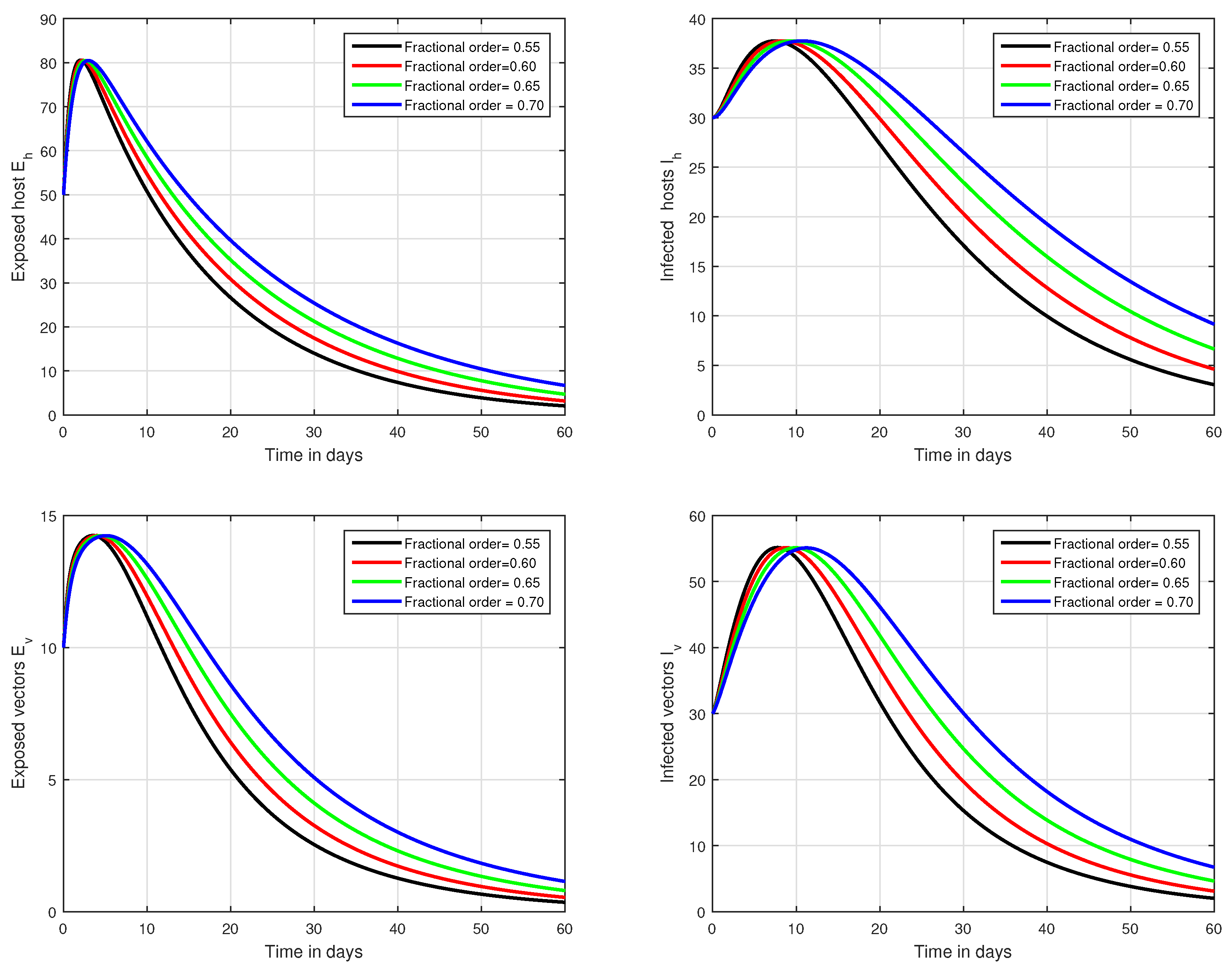


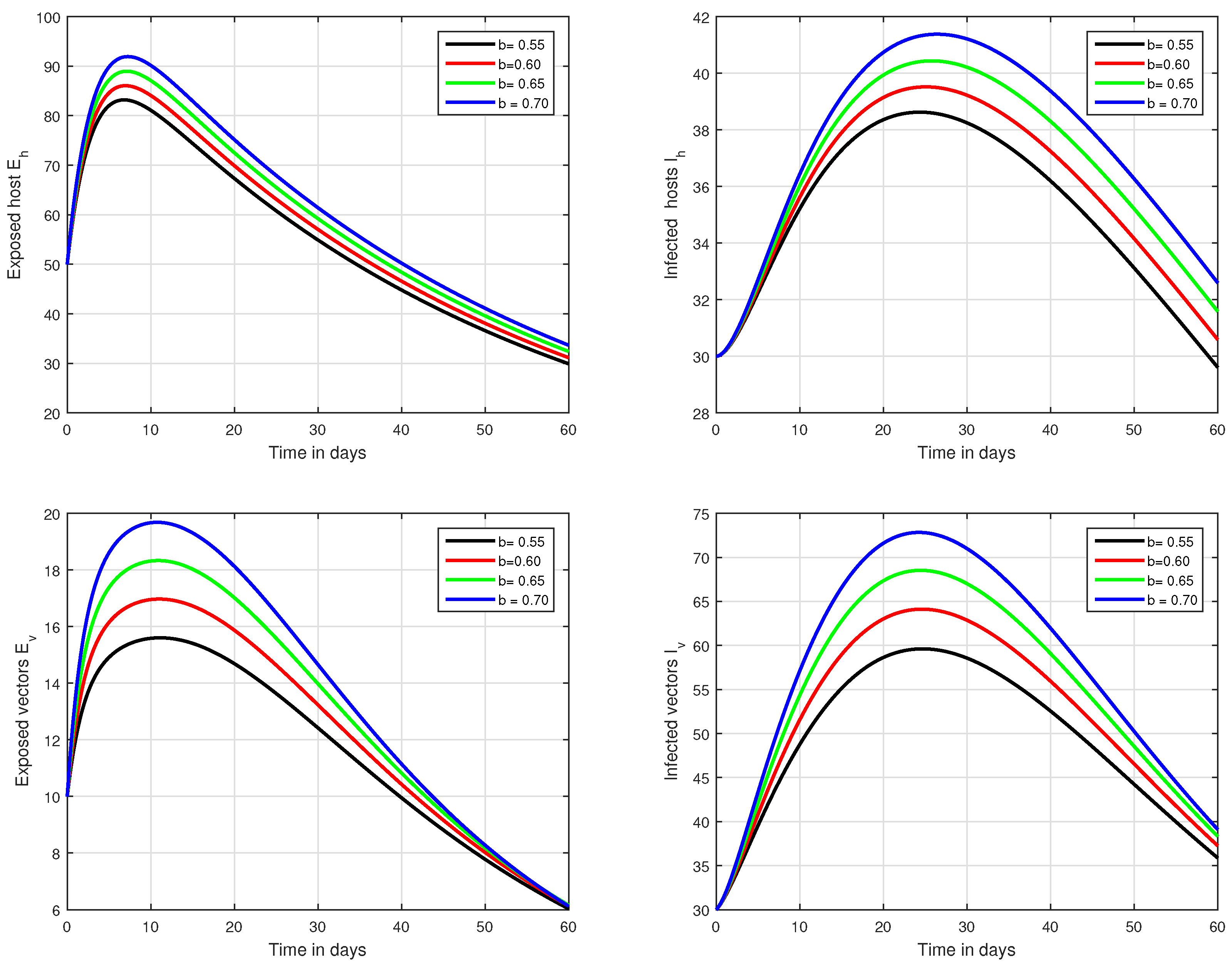
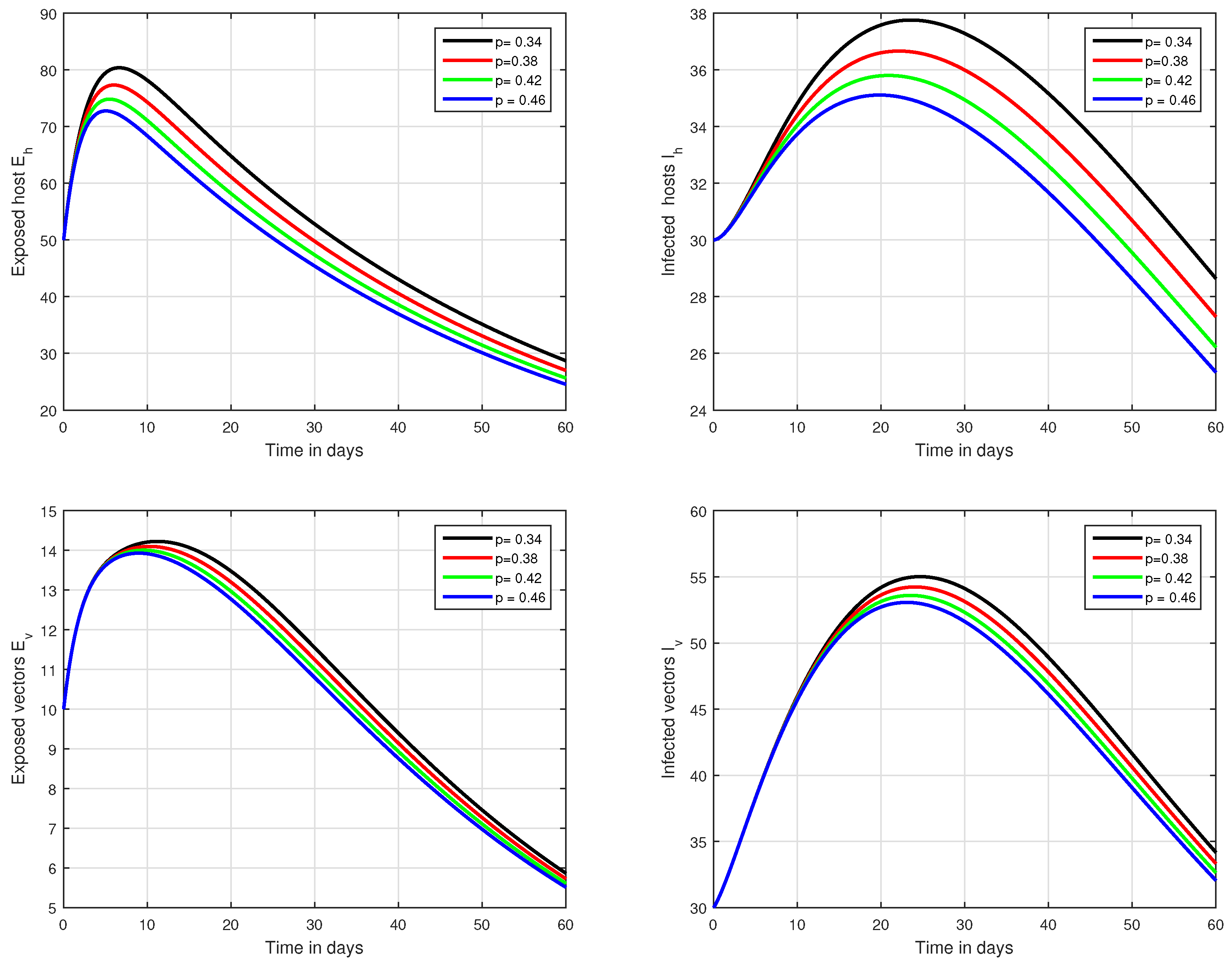
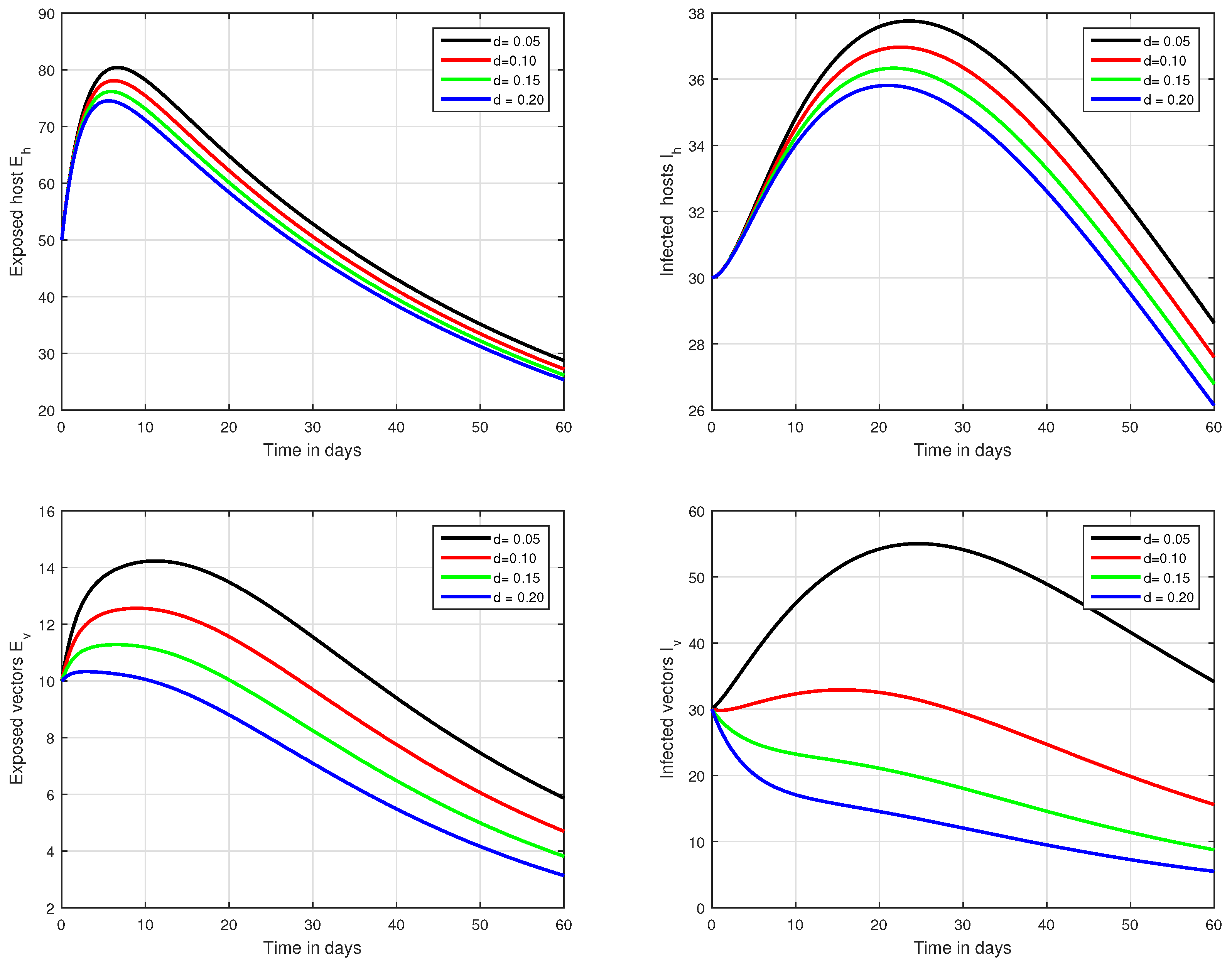
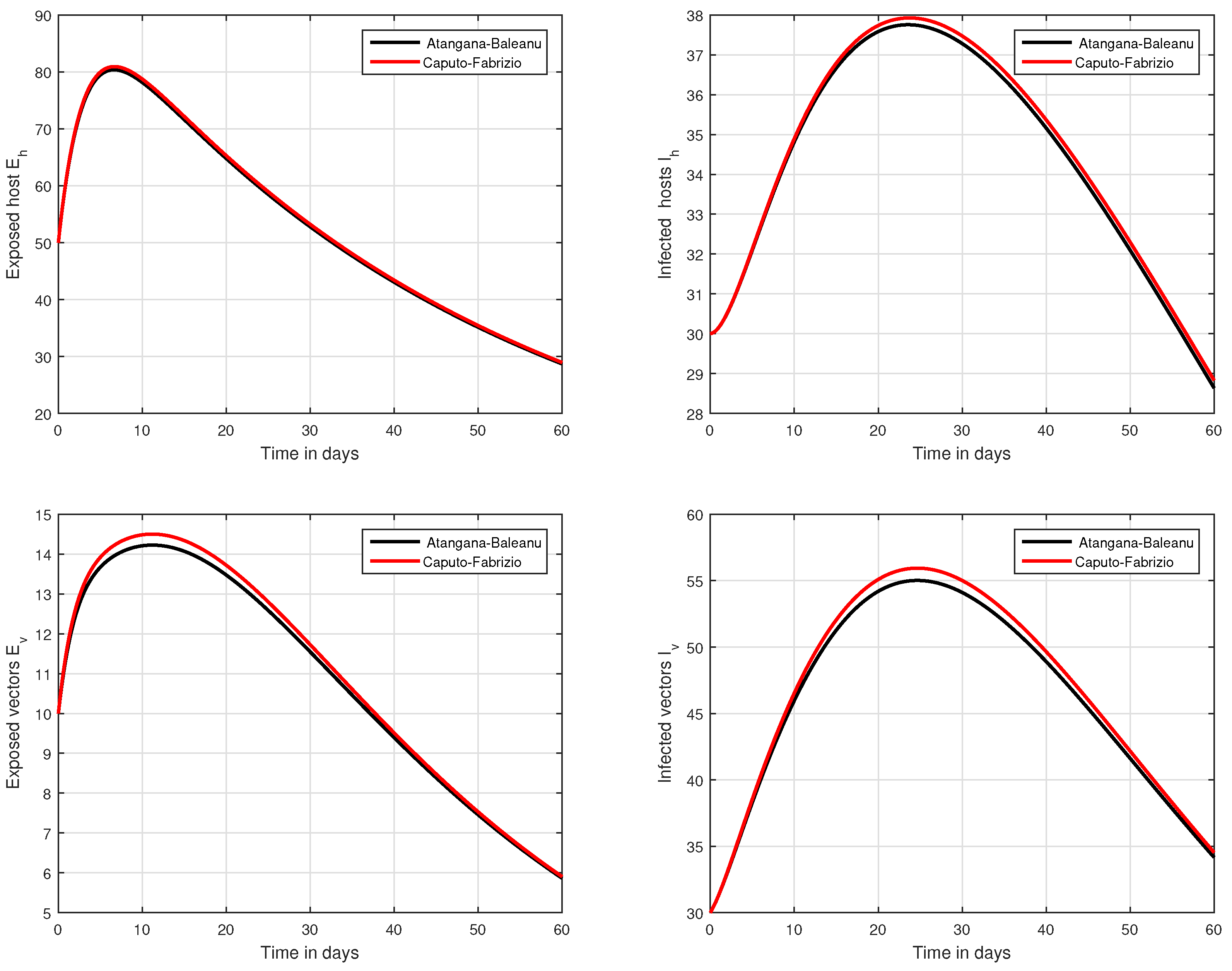

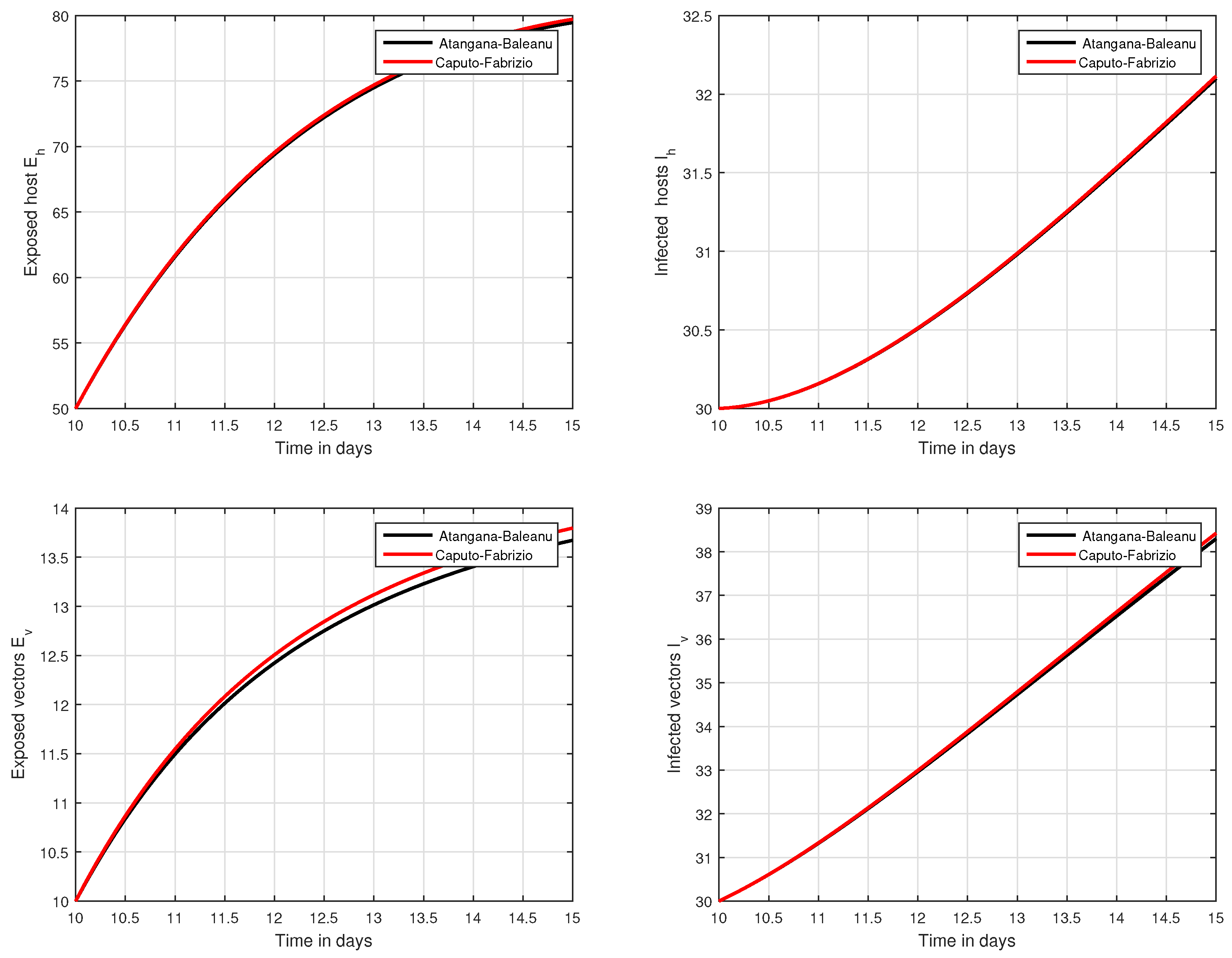
Publisher’s Note: MDPI stays neutral with regard to jurisdictional claims in published maps and institutional affiliations. |
© 2021 by the authors. Licensee MDPI, Basel, Switzerland. This article is an open access article distributed under the terms and conditions of the Creative Commons Attribution (CC BY) license (https://creativecommons.org/licenses/by/4.0/).
Share and Cite
Hussain, S.; Madi, E.N.; Iqbal, N.; Botmart, T.; Karaca, Y.; Mohammed, W.W. Fractional Dynamics of Vector-Borne Infection with Sexual Transmission Rate and Vaccination. Mathematics 2021, 9, 3118. https://doi.org/10.3390/math9233118
Hussain S, Madi EN, Iqbal N, Botmart T, Karaca Y, Mohammed WW. Fractional Dynamics of Vector-Borne Infection with Sexual Transmission Rate and Vaccination. Mathematics. 2021; 9(23):3118. https://doi.org/10.3390/math9233118
Chicago/Turabian StyleHussain, Shah, Elissa Nadia Madi, Naveed Iqbal, Thongchai Botmart, Yeliz Karaca, and Wael W. Mohammed. 2021. "Fractional Dynamics of Vector-Borne Infection with Sexual Transmission Rate and Vaccination" Mathematics 9, no. 23: 3118. https://doi.org/10.3390/math9233118






